Pelargonium carnosum subsp. carnosum
Pelargonium carnosum (L.) L’Hér. subsp. carnosum
Family: Geraniaceae
Common names: fleshy-stalk pelargonium (Eng.); vetplantmalva (Afr.)
Introduction
This attractive, drought-resistant, deciduous, succulent pelargonium is a winter grower that does not sprout after fire.
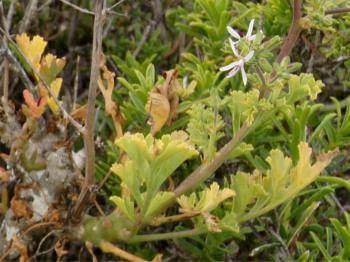
Description
Description
Pelargonium carnosum subsp. carnosum is a succulent shrub of up to 750 mm tall, with thick and fleshy stems that have a knobby appearance because of the somewhat swollen nodes. Young branches are sparsely covered with whitish hairs, but they become smooth with age. The slightly fleshy, grey-green, feather-like leaves, are up to 200 mm long and divided into many lobes, which are somewhat channeled above. This species shows great variability in leaf characters. At the onset of drought, the leaves dry and drop off.
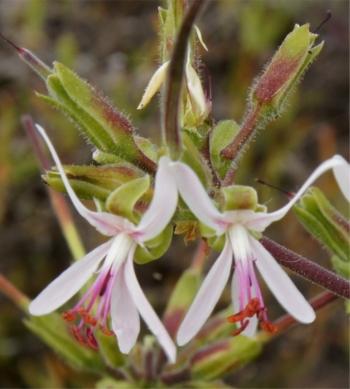
Inflorescences of plants from different habitats, vary considerably. Several pseudo-umbels with 2–8 flowers are borne on branched peduncles. The relatively small flowers vary from white to greenish yellow, with reddish streaks on the 2, slightly larger, upper petals. The flowering period is from autumn (April) to spring (September).
Conservation Status
Status
According to the Red List of South African plants, accessed on 06 February 2018, Pelargonium carnosum is assessed as Least Concern (LC), because the populations are widespread.
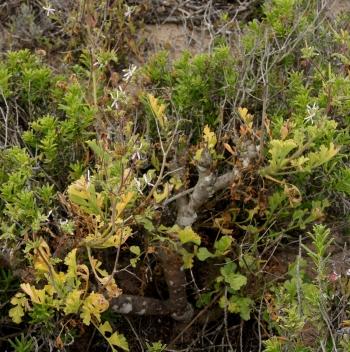
Distribution and habitat
Distribution description
Pelargonium carnosum is widely spread and occurs from southern Namibia and the western Karoo to the Eastern Cape. This plant is confined to xerophytic habitats and grows in sandy soil on flats or slopes as a component of semi-desert and karroid vegetation. It grows in the winter rainfall region and can withstand temperatures of 23ºC to 30ºC, and is not frost tolerant.
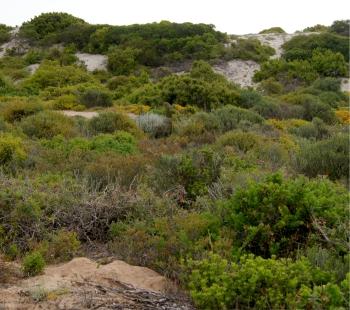
Derivation of name and historical aspects
History
Pelargonium carnosum was described by L’Heritier in 1789. The genus is named from the Greek pelargos, meaning ‘a stork’, which refers to the seed that resembles the beak of a stork. The specific epithet carnosum, means ‘fleshy’ or ‘succulent’, and refers to the succulent stems.
Two formerly recognised species, Pelargonium eberlanzii R.Knuth and Pelargonium ferulaceum (Burm.f.) Willd., are now included in P. carnosum subsp. carnosum.
There are about 270 species of Pelargonium, of which 220 species are found in southern Africa.

Ecology
Ecology
During the day, Pelargonium carnosum is pollinated by bees, wasps and bee flies. At night the flowers attract moths.
This species is adapted to surviving in dry conditions; the succulent stems store moisture.
Heat causes the seed pods to ripen quickly. Seeds are carried by the wind some distance away from the parent plant. Once they reach the ground they bore their way into the soil. This is possible because of the corkscrew tail attached to the end of the seed. As the wind blows, so the corkscrew turns, much like a drill bit. This is to ensure that most of the seeds will have a chance to germinate.
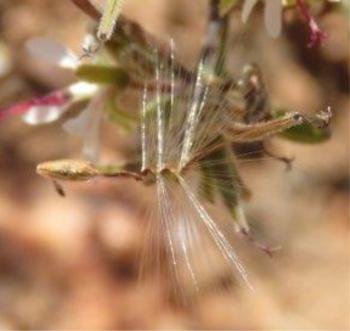
Uses
Use
Pelargonium carnosum has fleshy twigs which can be eaten as a snack. This pelargonium makes an ideal bonsai, is an excellent container plant and well suited for a rockery, and dry, winter-rainfall gardens.
Growing Pelargonium carnosum subsp. carnosum
Grow
Pelargonium carnosum grows in winter and is dry and dormant in summer, and needs a dry summer period. Take care not to over-water.
Propagate from seed or by cuttings. Collect the seed once ripe. Sow the seed in autumn (April/May), when the growing season commences for this plant. Sow in a well-drained, sandy, loam soil medium approximately 10 mm below the soil surface. Keep moist, well ventilated, allow sufficient light and place in a warm area. The seeds will germinate in 2 to 4 weeks. The seedlings should be ready for planting by the next autumn. The seedlings should be fat and healthy (about 20 mm in diameter), before they are pricked out carefully, without damaging the roots. Move to a sunny location.
If one wishes to propagate by cuttings, it is advisable to harvest material in early autumn when the plant is starting to produce its first set of leaves of the season. It is at this stage that the plant is at its most productive.
Once the cutting is taken, allow the wound to seal and leave it to dry out for 2 weeks. The cutting should be 100–150 mm long. Ensure the cutting is healthy and has plenty of new growth on it. Use river sand to strike the cuttings in. A misting 4 times a day in autumn (April), should suffice. Ensure that the area where the cuttings are placed to root is well ventilated, and that there is enough natural light (approx. 50%). Under the right conditions, the cuttings should root within 2 to 3 months. Rooting is a lot slower than the other species of Pelargonium.This is because of the caudiciform (thick succulent stem) growth of the plant. Plant out in sandy loam with very well-rotted compost. Move to a sunny location. By early summer (October/November), the plants should be strong enough to be planted in a pot.
Grow Pelargonium carnosum nestled in between the rocks in a rockery with companion plants like, Aloe microstigma (Karoo Aloe), Cotyledon orbiculata (Pig’s Ears or Plakkie), Euphorbia mauritanica (Yellow Milk Bush), Othonna retrofracta, Pelargonium alternans (Koolmalva), Tylecodon paniculatus (Butter Tree or Botterboom) and Pteronia incana (grey gumbush).
White scale can be found on the bottom stems. Use a horticultural oil to smother these pests. Take care not to spray when the plants are in flower. Caterpillars feed on the flower buds of this pelargonium.
References
- Le Roux, A. 2015. Wild flowers of Namaqualand. Struik Nature. Cape Town.
- Van der Walt, J.J.A. 1977. Pelargoniums of southern Africa. Purnell, Cape Town.
- Vlok, J. & Schutte-Vlok, A-L. 2015. Plants of the Klein Karoo. Umdaus Press, Hatfield.
Credits
Prudence Samukelisiwe Ntuli
Karoo Desert National Botanical Garden
October 2018
Plant Attributes:
Plant Type: Shrub, Succulent
SA Distribution: Northern Cape, Western Cape
Soil type: Sandy
Flowering season: Spring, Autumn
PH: Acid, Neutral
Flower colour: White
Aspect: Full Sun
Gardening skill: Average
Special Features:
Horticultural zones








Rate this article
Article well written and informative
Rate this plant
Is this an interesting plant?
Login to add your Comment
Back to topNot registered yet? Click here to register.